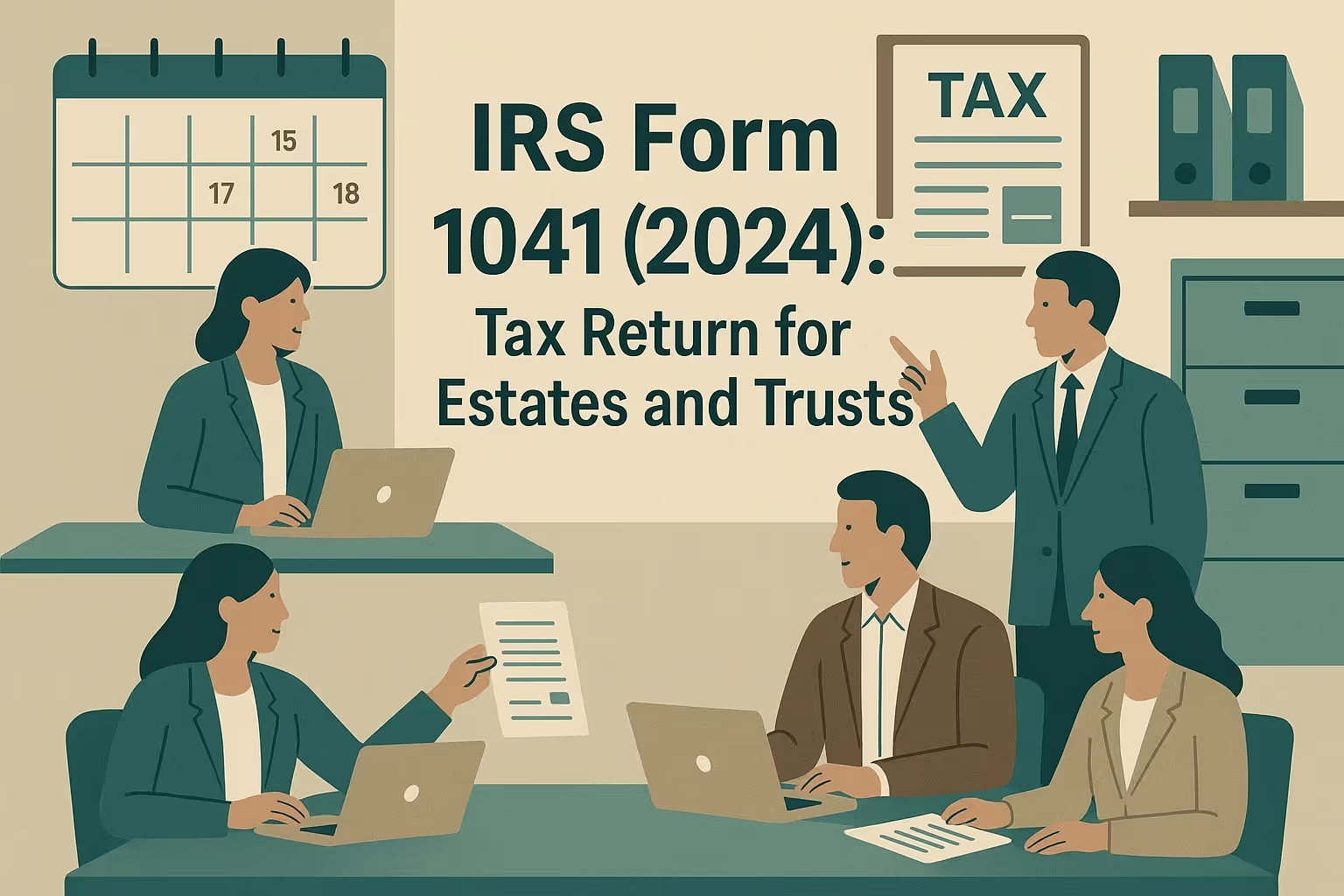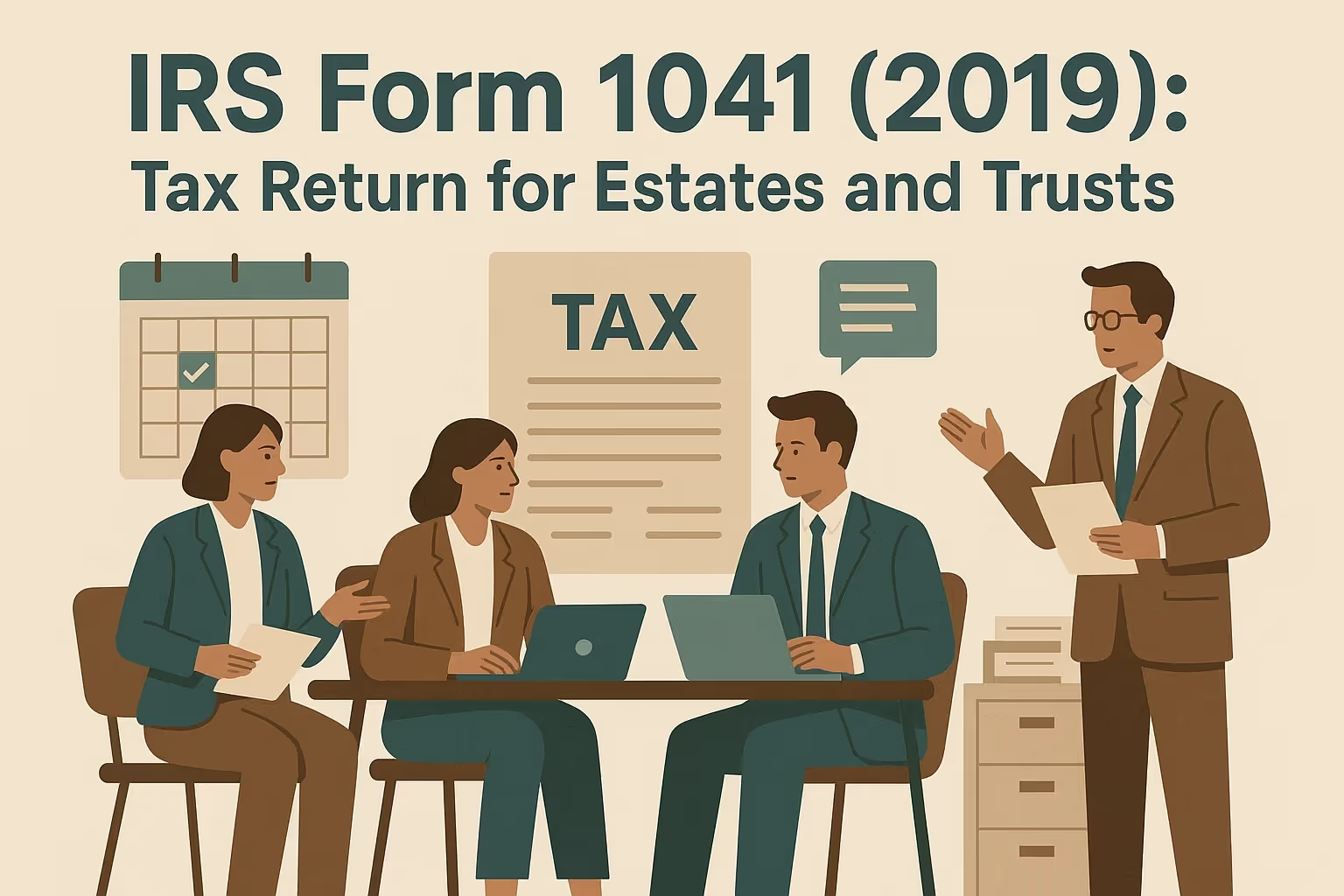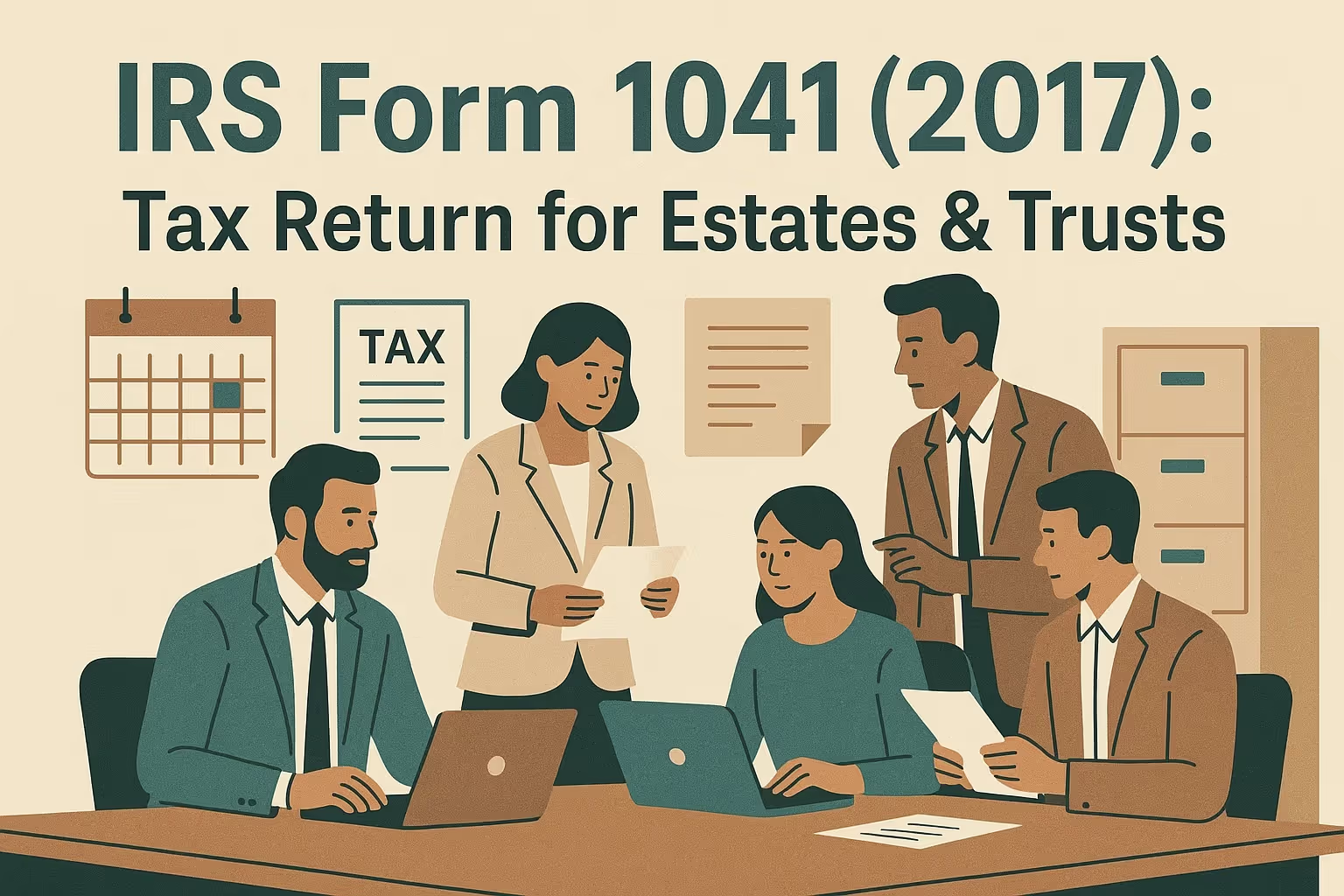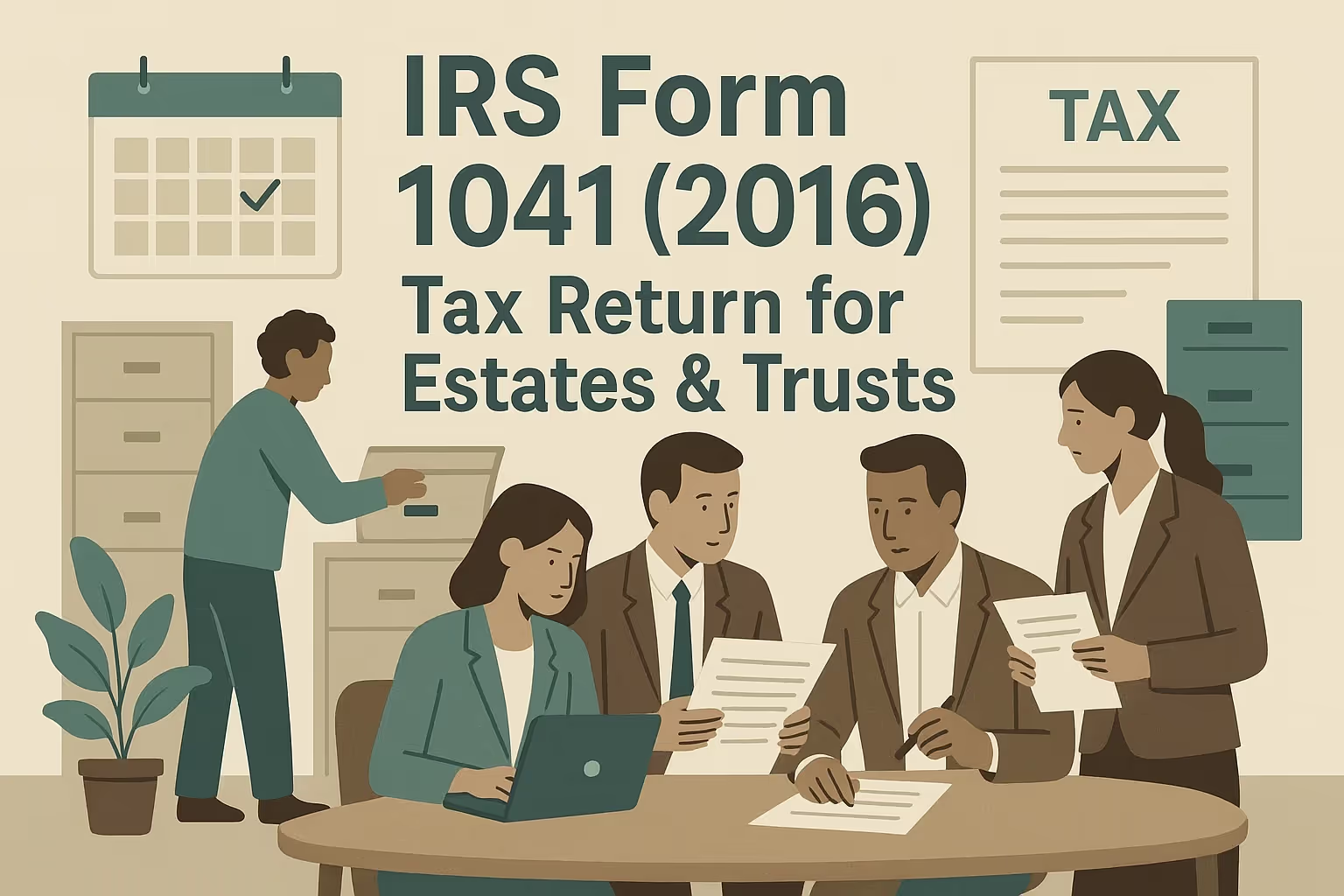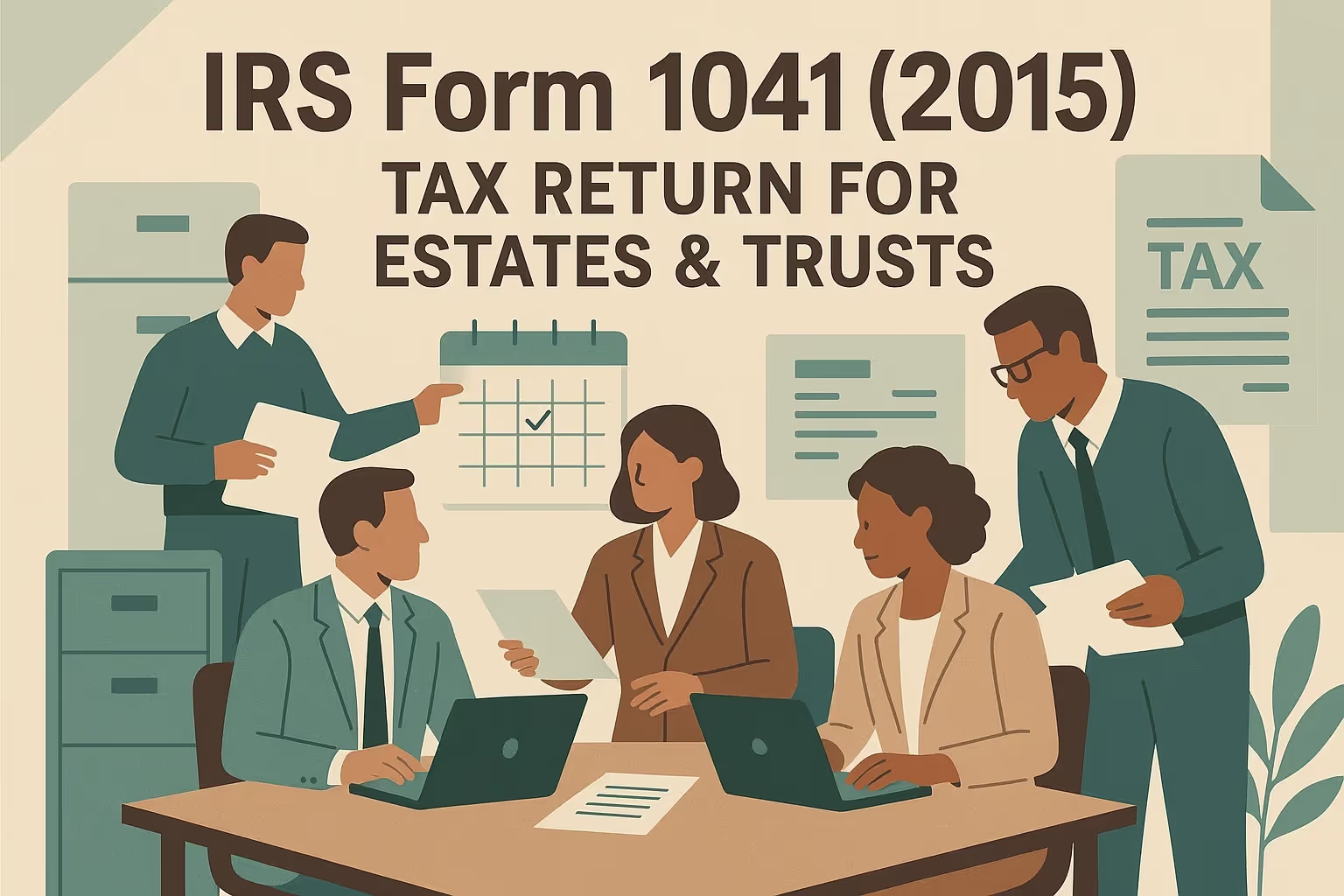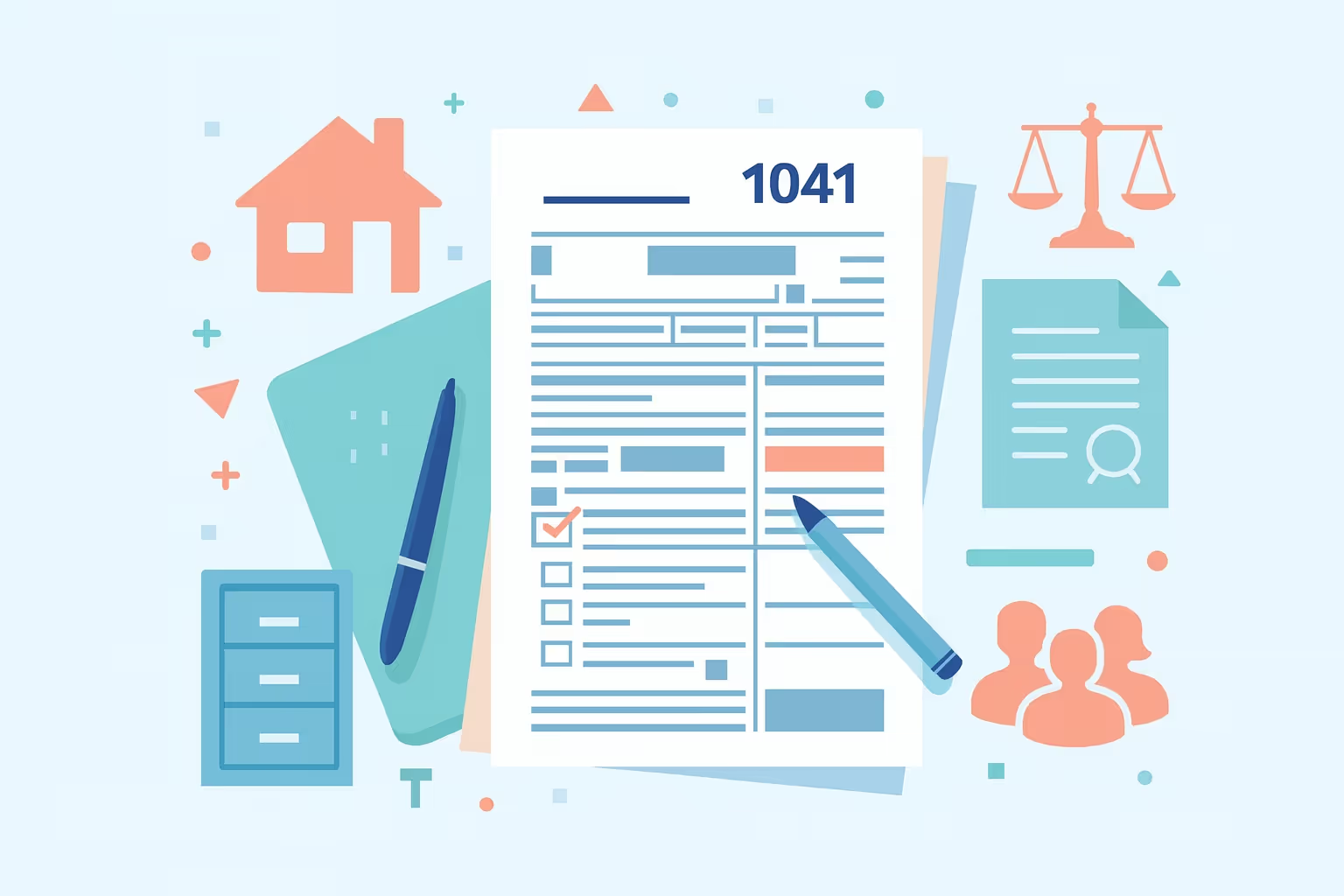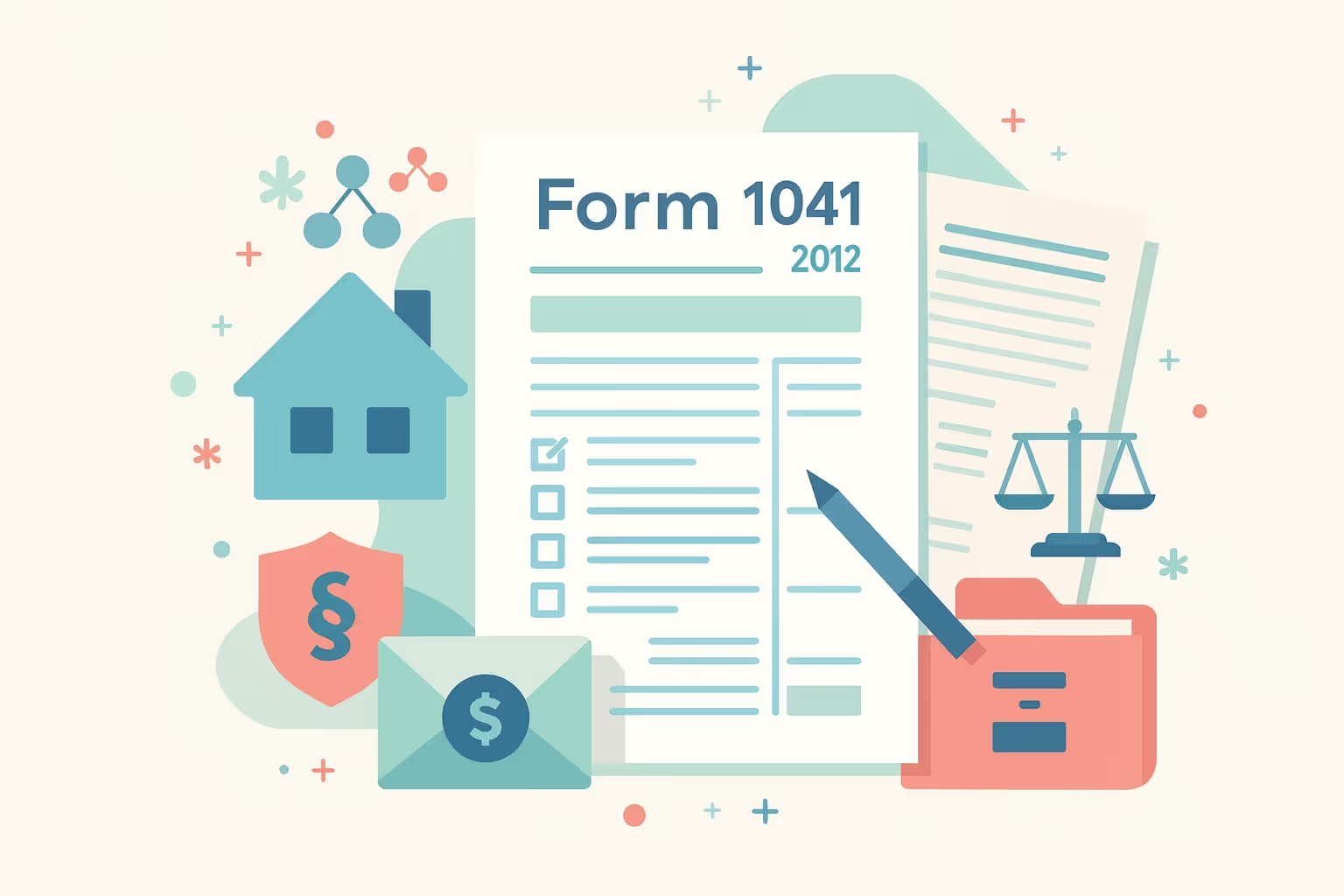How to File Federal Form 1041 for Tax Year 2020
Over 3 million fiduciary income tax returns were filed with the Internal Revenue Service in 2020, yet thousands were delayed due to avoidable errors and missed deadlines. If you are responsible for filing federal Form 1041 for tax year 2020, you are handling an estate or trust's official income tax return. This separate taxable entity must report gross income, deductions, capital gains, and other income categories. Fiduciaries, executors, and trustees must legally submit the return, issue Schedule K-1 to each beneficiary, and pay any tax owed on time. Filing correctly and on time is not optional: late returns can trigger 5% monthly penalties on unpaid tax and delay distributions to beneficiaries.
Unfortunately, completing Form 1041 involves more than simply adding income from savings accounts or mutual funds. It requires understanding terms like "distributable net income" and "income distribution deduction," properly allocating expenses for tax payment purposes, and accurately reporting ordinary business income and capital gains. Missing even one detail, such as the date of the decedent’s death, or failing to include an extension payment, can result in costly mistakes, rejected filings, or months-long processing delays. These errors not only increase your income tax liability but can also frustrate beneficiaries waiting for their share.
This guide will walk you through filing Form 1041 for 2020. You will learn to determine whether you must file Form 1041, gather the necessary documents, calculate estimated income tax payments, and decide between paper and electronic filing. Each section will include clear instructions, practical examples, and checklists to help you avoid errors and meet critical deadlines. By following this process, you can minimize risk, speed up refunds, and protect the financial interests of the estate or trust you manage.
Understanding Federal Form 1041 for Tax Year 2020
Before you start preparing schedules and gathering records, it is essential to understand what Form 1041 is and why it matters. The IRS treats estates and trusts as separate taxable entities, which means their income, deductions, and credits must be reported on their own return rather than on a personal income tax return.
What Is Form 1041?
Form 1041 is officially titled the “U.S. Income Tax Return for Estates and Trusts.” It is the federal document that fiduciaries use to report gross income, deductions, capital gains, and alternative minimum tax for an estate or trust.
The return calculates the estate’s taxable income, determines the income tax liability, and specifies whether any refunds or payments are due. Think of it as the 1040 for an estate or trust—it serves the same purpose but follows different rules under the Internal Revenue Code.
Filing is not just a reporting obligation: it ensures that beneficiaries’ share of income is correctly documented on Schedule K-1, allowing beneficiaries to report their portion on their own tax returns. This is critical for compliance and avoiding mismatches that may trigger IRS notices.
Who Must File Form 1041?
Not every estate or trust is required to file, but the rules are strict:
- Estates: A decedent’s estate must file if it has an annual gross income of $600 or more during the tax year or if any beneficiary is a nonresident alien. Even a small amount of interest from income-producing assets like savings accounts may create a filing requirement.
- Trusts: A trust must file if it has any taxable income, gross income of $600 or more, or a nonresident alien beneficiary.
- Exceptional Cases: Bankruptcy estates, foreign trusts, and electing small business trusts (ESBTs) have special rules. Fiduciaries should review IRS guidance carefully to ensure compliance.
Key Tax Concepts Fiduciaries Must Understand
Several terms play a significant role in preparing a correct return:
- Distributable Net Income (DNI): This figure determines how much income is taxable to the estate versus how much is passed through to beneficiaries. It is a key part of Schedule B.
- Income Distribution Deduction: Estates and trusts can deduct amounts distributed to beneficiaries, reducing total income subject to tax.
- Income Categories Reported: Fiduciaries must report interest, dividends, ordinary business income, rental income, and gains from designated assets like stocks or real estate.
By understanding these rules early, you can avoid costly mistakes, allocate income correctly, and ensure that the return accurately reflects the estate or trust’s financial activity.
Significant Changes for Tax Year 2020
Once you know that your estate or trust must file, the next step is to review updates that affect the federal Form 1041 for tax year 2020. Several provisions from the CARES Act and IRS adjustments directly impact how estates and trusts calculate taxable income, deductions, and credits. Understanding these changes will help you avoid filing an outdated tax return or missing key opportunities to reduce income tax liability.
CARES Act Updates
Congress introduced major tax relief provisions that impacted income tax return preparation for estates and trusts.
- NOL Carryback: Net operating losses arising in 2018, 2019, or 2020 can now be carried back five years. Fiduciaries may waive the carryback by attaching a statement to the return.
- Excess Business Loss Repeal: The limit on excess business losses was suspended for tax years 2018 through 2020. This may allow additional deductions if the estate or trust has ordinary business income.
Business Interest Deduction and Credits
The limit for deducting business interest expense increased from 30% to 50% of adjusted taxable income. If the estate or trust deducts business interest, you may need to attach Form 8990 for compliance.
Additionally, the CARES Act introduced two new credits:
- Employee Retention Credit: This credit is available to qualifying estates or trusts that paid wages to employees during the pandemic. Claiming it can significantly reduce the estate or trust’s annual income tax liability.
- Sick and Family Leave Credits: These credits must be reported on the new lines 17 and 18 of Schedule G. They provide tax relief for estates and trusts that compensated employees for qualified sick or family leave.
Updated Tax Rates and Exemptions
The IRS adjusted tax brackets and exemptions for estates and trusts in 2020. This table summarizes the key rates:
- Taxable Income: Up to $2,600
- Tax Rate: 10%
- Taxable Income: $2,601 – $9,450
- Tax Rate: 24%
- Taxable Income: $9,451 – $12,950
- Tax Rate: 35%
- Taxable Income: Over $12,950
- Tax Rate: 37%
Other key updates include:
- The qualified disability trust exemption has increased to $4,300 for the 2020 tax year. This allows qualified disability trusts to shield more income from taxation.
- The filing threshold for bankruptcy estates has risen to $12,400. This change ensures that only estates with an annual gross income above this amount must file a return.
- The state and local tax (SALT) deduction remains capped at $10,000 for estates and trusts. In addition, foreign real property taxes are no longer deductible for tax payment purposes.
Keeping these changes in mind ensures your income tax calculations reflect current rules and helps prevent mismatches between reported total income and actual tax owed.
Preparation Checklist Before Filing
Proper preparation is the easiest way to avoid mistakes and keep your federal Form 1041 for tax year 2020 on track. Gathering all records before you start filling out the form will help you accurately calculate the estate’s taxable income and prevent IRS notices about missing information.
Preparation Steps for Fiduciaries
- Obtain or verify the Employer Identification Number (EIN): Every estate or trust must have its own EIN since it is treated as a separate taxable entity. Apply online through the Internal Revenue Service if you do not already have one. This number is required for all filings and estimated income tax payments.
- Gather All Income Records: Collect 1099 forms, K-1s, and statements from savings accounts, mutual funds, and other income-producing assets. Be sure to include ordinary business income, wages paid, and any income generated from rented property or designated asset sales.
- Review Governing Documents: Carefully read the will, trust agreement, and any amendments. Confirm who the primary beneficiary is, the powers of the estate executor, and any required timing for income distributed to beneficiaries.
- Collect Documentation for Expenses: Keep receipts and statements for fiduciary fees, professional fees, property taxes, and other administration costs. These are crucial when calculating deductions and the income distribution deduction.
- Reconcile Estimated Tax Payments: Match prior estimated tax payments against IRS records. If additional tax is due, plan to make an extension payment with Form 7004 to avoid penalties.
- Determine Special Elections: Some estates can elect under Section 645 to treat the trust as part of the decedent’s estate for tax purposes. Review whether these apply to reduce reporting complexity.
Preparing thoroughly allows you to complete the form in fewer steps, minimize errors in reporting total income, and inform beneficiaries of progress.
Step-by-Step Instructions for Completing Form 1041
Once your documents are organized, you can complete the federal Form 1041 for the 2020 tax year. This section walks through each significant part of the form so you can correctly report total income, calculate deductions, and avoid penalties.
Step 1 – Complete the Header
The top section of Form 1041 is where you identify the estate or trust.
- Name and Address: Enter the exact legal name of the estate or trust as it appears on the employer identification number (EIN) application. Include the name and title of the estate executor or personal representative.
- Entity Type: Check all applicable boxes, including decedent’s estate, simple trust, or complex trust.
- Date Entity Created: This is the date of the decedent’s death for estates. For trusts, it is the date established under the trust agreement.
- Other Key Details: Provide the filing year, whether this is a final return, and whether joint fiduciaries are responsible for signing.
Completing this section accurately ensures the IRS can match the return with prior filings and apply payments correctly.
Step 2 – Report Income (Lines 1–9)
This part determines the estate or trust’s income for the year. You will report all income categories using the lines provided:
- Income Category: Interest income
- Notes: Include bank interest from savings accounts and bonds. Attach Schedule B if over $1,500.
- Income Category: Dividends
- Notes: Report all ordinary and qualified dividends, including those from mutual funds.
- Income Category: Ordinary business income
- Notes: Use Schedule C if the estate operates a business.
- Income Category: Capital gains/losses
- Notes: Attach Schedule D and Form 8949 for all asset sales. Include gains from designated assets like stocks or rented property.
- Income Category: Rents, royalties, partnerships
- Notes: Report income earned from partnerships, S corporations, or rental property. Attach Schedule E.
- Income Category: Other income
- Notes: Include IRD (income in respect of a decedent) and final paychecks received after the decedent passes.
Be thorough when reporting all income earned: even small amounts can trigger filing requirements or change the estate’s taxable income.
Step 3 – Calculate Deductions (Lines 10–21)
The IRS allows several deductions to reduce income tax liability:
- Line 10: Deduct all interest paid during the year, including any investment interest. This amount directly reduces the estate or trust’s total income before calculating taxable income.
- Line 11: Report all deductible taxes paid, including state and local taxes, but remember the SALT deduction is capped at $10,000. This cap applies to the combined total of state income taxes and property taxes.
- Line 12: Deduct fiduciary fees and professional fees that were necessary for the administration of the estate or trust. Only expenses that would not have been incurred if the estate did not hold the property or trust are allowed.
- Line 13: Enter charitable contributions made by the estate or trust and complete Schedule A to support the deduction. Ensure that contributions meet IRS requirements and are made to qualified organizations.
- Line 18: Calculate the income distribution deduction on Schedule B and report it here. This deduction is essential because it shifts taxable income to the beneficiaries rather than taxing it at the estate or trust level.
- Line 20: Claim the qualified business income deduction by completing Form 8995 or 8995-A. Attach all required statements to show the beneficiaries’ shares of the deduction if applicable.
- Line 21: Report the exemption amount based on the entity type. The exemption is $600 for estates, $300 for simple trusts, $100 for complex trusts, and $4,300 for qualified disability trusts.
Accurate deductions lower the estate’s taxable income and ensure the correct beneficiary’s share of tax is passed through.
Step 4 – Compute Tax, Payments, and Credits
After subtracting deductions from total income, compute the tax:
- Line 23: Calculate taxable income by subtracting all allowable deductions from the estate or trust’s total income. This figure is the basis for determining the final income tax liability.
- Line 24: Determine the total tax owed by applying the estate and trust tax rate schedule to the taxable income. If the estate or trust has capital gains, use the special capital gains tax computation to apply the correct rate.
- Lines 25–28: Enter all estimated tax payments, federal income tax withheld, and any refundable credits claimed during the tax year. This step ensures the IRS properly credits payments already made toward the tax liability.
- Lines 29–30: Compute whether the estate or trust has a balance due or is owed a refund. If a balance is due, you may pay electronically using the Electronic Federal Tax Payment System (EFTPS) or IRS Direct Pay to avoid mailing delays.
This section is critical for managing cash flow and avoiding interest charges.
Step 5 – Prepare Schedules and K-1s
Schedules are essential to support what you report:
- Schedule B: Complete this schedule to show how distributable net income is calculated for the estate or trust. The result determines both the income distributed to beneficiaries and the amount of the income distribution deduction allowed to the estate or trust.
- Schedule K-1: Prepare a separate Schedule K-1 for each beneficiary to report their share of income, deductions, and credits. Failing to file accurate and timely K-1s can lead to a $280 penalty per form, so double-check all entries before distributing them.
- Schedule I: File this if the estate or trust owes alternative minimum tax. It calculates and reports the AMT separately to ensure compliance with IRS requirements.
Take time to assemble these correctly—they are often the most common source of IRS correspondence when errors occur.
Step 6 – Review and Sign
Before filing, double-check every entry:
- Match Totals Across Schedules: Carefully check that all totals match Form 1041 and the attached schedules. Inconsistent figures are among the most common reasons the IRS delays processing or issues a notice.
- Verify Key Details: Before filing, confirm that the EIN, calendar year, and mailing address are accurate. Incorrect information can cause misapplied payments or rejected returns.
- Sign the Return Properly: Ensure the return is signed by the estate administrator, personal representative, or authorized tax preparer. Unsigned returns are considered invalid and will not be processed by the IRS.
Careful review before submission can prevent the IRS from rejecting the return or issuing notices for mismatches.
How to File: Paper vs. Electronic
Once your federal Form 1041 for the 2020 tax year is complete, the next decision is how to submit it. The IRS strongly encourages electronic filing for faster processing, but some fiduciaries still choose paper returns. Understanding both methods will help you decide what is best for your situation.
Benefits of Electronic Filing
Electronic filing offers several advantages that save time and reduce errors:
- Faster Processing: E-filed returns are usually processed within 21 days, compared to 6–8 weeks for paper returns.
- Immediate Confirmation: You receive a notice the next business day confirming the IRS accepted your tax return for estates.
- Fewer Errors: Built-in validation catches math mistakes and missing schedules before submission.
- Electronic Payments: You can schedule estimated tax or final payments online, ensuring timely compliance.
To e-file, you must use an authorized e-file provider or a qualified tax preparer. Signature authorization requires Form 8453-FE or Form 8879-F. Remember, Form 8879-F can only be used for a single return.
Paper Filing Steps
Paper filing is still an option for estates and trusts without e-file access or those with very complex attachments:
- Print the completed Form 1041 and all schedules using black ink.
- Sign as the estate executor, personal representative, or fiduciary in blue ink.
- Assemble forms in the proper order: Form 1041, schedules, and supporting statements.
- Include Form 1041-V if mailing a payment by check or money order.
Filing Type
Mailing Address (No Payment)
Mailing Address (With Payment)
Calendar year estates and trusts
IRS address for your state (from 2020 instructions)
Payment-specific address (from 2020 instructions)
Using the correct address prevents delays in processing and ensures payments are appropriately credited.
Payments, Deadlines, and Extensions
After completing the federal Form 1041 for the 2020 tax year, the final step is to ensure that payments are made on time. Missing deadlines can lead to penalties of 5% per month on unpaid tax and interest charges that continue to accrue until the balance is paid. Understanding the calendar year estates, quarterly payments, and extensions rules will help you avoid unnecessary costs.
Filing and Payment Deadlines
- Calendar Year Estates and Trusts: These entities must file their income tax return by April 15, 2021. If the due date falls on a weekend or federal holiday, the deadline moves to the next business day.
- Fiscal Year Filers: Estates and trusts operating on a fiscal year must file by the 15th day of the fourth month following the end of the fiscal year. This ensures proper reporting for all income earned during the year.
- Extension of Time: You may request an automatic 5½-month extension using Form 7004. Remember that an extension only gives you more time to file, not more time to pay the tax owed.
Estimated Tax Payments
If the estate or trust expects to owe $1,000 or more in income tax liability, it must make quarterly estimated tax payments using Form 1041-ES.
- Due Dates: Payments are generally due April 15, June 15, September 15, and January 15 of the following year.
- Safe Harbor Rule: Pay the smaller of 90% of the current year’s taxable income liability or 100% of the prior year’s tax to avoid underpayment penalties (110% if the previous year’s adjusted gross income was over $150,000).
Extension Payments
If you cannot file by the deadline, submit an extension payment with Form 7004. Paying at least 90% of the tax due with the extension helps avoid penalties and interest. You may pay online using EFTPS, IRS Direct Pay, or by check using Form 1041-V.
Timely payments keep the estate or trust compliant and prevent interest from reducing funds available to beneficiaries.
Common Filing Mistakes to Avoid
Even well-prepared fiduciaries can make mistakes when filing the federal Form 1041 for tax year 2020. These errors often delay refunds, increase income tax liability, or trigger IRS notices. Reviewing the most frequent issues will help you avoid them.
Critical Filing Errors
- Incorrect EIN or Entity Information: Filing without obtaining an EIN or using the wrong entity name can result in rejected returns. Apply for an EIN before filing and double-check all information against IRS records.
- Unreported Income: Failing to report interest, dividends, or income generated from savings accounts, mutual funds, or rented property may trigger IRS matching notices. Carefully reconcile all 1099s and statements before submitting the income tax return.
- Deduction Errors: Deducting more than $10,000 in SALT taxes or claiming ineligible expenses can result in reduced deductions after IRS review. Always confirm that expenses are tied to the administration of the estate or trust.
- Schedule K-1 Problems: Late or inaccurate K-1s can incur a $280 penalty per form. Prepare and distribute them by the due date, and ensure that each beneficiary’s share of income is accurate.
- Missed NOL or Credit Elections: Not attaching election statements for NOL carrybacks or credits may forfeit tax benefits. Attach all required supporting documentation.
Signature and Assembly Issues
- Unsigned Returns: An unsigned return is considered invalid and will not be processed.
- Incorrect Assembly Order: Submitting schedules incorrectly or using outdated forms can delay processing. Always follow the current year’s assembly instructions.
Avoiding these mistakes protects the estate or trust and helps beneficiaries receive distributions without costly delays.
First-Time Fiduciary Tips
Filing federal Form 1041 for tax year 2020 for the first time can feel overwhelming, especially when balancing deadlines, paperwork, and the expectations of beneficiaries. These tips will help you stay organized and confident as you take on this responsibility.
Practical Steps for First-Time Filers
- Open a Separate Bank Account: Open a dedicated account with the estate or trust’s employer identification number (EIN). This keeps income generated and expenses separate from personal funds, making recordkeeping easier.
- Track All Income and Expenses: Maintain detailed records of interest, dividends, ordinary business income, and professional fees paid. Good documentation supports deductions and ensures accurate reporting of taxable income.
- Document Distributions Carefully: Keep a written log of all distributions to beneficiaries. This ensures the beneficiary’s share on Schedule K-1 matches the amounts received and avoids disputes later.
- Plan for Deadlines: Use a calendar to track quarterly estimated tax payments, filing deadlines, and distribution dates. This reduces the risk of penalties and helps maintain good communication with beneficiaries.
- Consider Professional Help: If the estate owns income-producing assets, has joint fiduciaries, or is a business entity, consult a qualified tax preparer. Their guidance can help you claim all allowable deductions and avoid mistakes that could increase income tax liability.
Stay Proactive
Acting as an estate administrator means informing beneficiaries, responding to IRS notices quickly, and filing all forms on time. A proactive approach will assure beneficiaries that the estate or trust is properly managed.
FAQs
What is the due date for the federal Form 1041 for the 2020 tax year?
For calendar year estates and trusts, the tax return for estates must be filed by April 15, 2021. If the due date falls on a weekend or holiday, it moves to the next business day. You may request an automatic 5½-month extension using Form 7004, but you must still make any required extension payment to avoid penalties and interest charges on unpaid balances.
Do I need to file Form 1041 if the estate earned less than $600?
You may not need to file if your annual gross income is under $600 and there are no nonresident alien beneficiaries. However, if the estate has taxable income or is a foreign trust, filing may still be required. When in doubt, check IRS guidelines or consult a qualified tax preparer to avoid penalties for failing to file when needed.
How do I report a beneficiary’s share of income?
Use Schedule K-1 to report each beneficiary’s share of income distributed, deductions, and credits. This schedule ensures beneficiaries correctly include their amounts on their personal income tax returns. Filing K-1s late or with errors may result in a $280 penalty per K-1, so prepare them carefully and distribute them on or before the due date for the estate or trust’s return.
Can I e-file Form 1041?
Yes, the IRS encourages electronic filing for estates and trusts because it reduces errors and speeds up refunds. You must use an authorized e-file provider or a qualified tax preparer. After filing, you will receive confirmation within one business day, which helps you track compliance and ensures the IRS accepted the return for processing without requiring additional manual review.
What happens if I file late or underpay?
Late filing can result in a penalty of 5% per month of unpaid income tax liability, up to 25%. Underpayment penalties apply even if a refund is due. Interest continues to accrue until the balance is paid in full. Making timely estimated tax payments and using the IRS safe harbor rules are the best ways to avoid these additional costs and protect estate assets.






